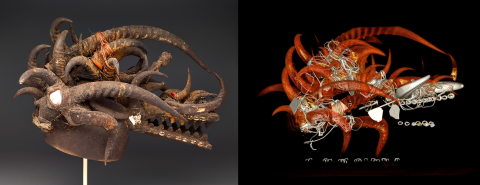—Unique Collaboration with UT Southwestern Department of Radiology Provides
Never-Before-Seen Features—

Dallas, TX—November 19, 2019—The Dallas Museum of Art’s Conservation and Arts of Africa departments, in an exciting collaboration with the University of Texas Southwestern Medical Center, will provide a never-before-seen look at the composition of a West African helmet mask from the Museum’s extensive collection. Not Visible to the Naked Eye: Inside a Senufo Helmet Mask features a komo mask made by the Senufo peoples presented alongside CT scans performed at UT Southwestern Medical Center that reveal unexpected materials beneath the surface that empower the mask.
The exhibition was organized by Dr. Roslyn Walker, Senior Curator of the Arts of Africa, the Americas, and the Pacific and The Margaret McDermott Curator of African Art, and Fran Baas, Interim Chief Conservator. Walker and Baas worked closely with Dr. Matthew A. Lewis and Dr. Todd Soesbe, faculty members of the Department of Radiology at the Medical School of the University of Texas Southwestern Medical Center, to perform these cutting-edge techniques.
“This exciting exhibition is the incredible result of a collaboration between the DMA’s curatorial and conservation expertise and the resources of an important local institution, the UT Southwestern Medical Center,” said Dr. Agustín Arteaga, The Eugene McDermott Director. “We’re thrilled to have joined forces to use cutting-edge scientific resources that reveal new stories about our collection and to share them with our audiences.”
A komo mask is worn like a helmet by a member of the powerful male-only Komo society at ceremonies and secret events. The Komo society has traditionally maintained social and spiritual harmony in Senufo villages in Côte d’Ivoire, Mali, and Burkina Faso. The mask derives its power from the accumulated sacrificial offerings that make up the textured surface. Visible elements include prominent animal horns, glass, metal wire, and a figurine, but there are hidden components embedded in the object that are impossible to detect without technological assistance.
Beginning in 2017, Lewis and Soesbe performed a visual analysis and binocular microscopy, X-Ray Fluorescence (XRF), Fourier-Transform Infrared Spectroscopy (FTIR), and spectral imaging CT scan tests. The visual analysis documented what was visible on the exterior—reedbuck antelope horns, wood, cowrie shells, mirrors and glass, and a small pamphlet. The XRF identified the wire as iron alloy. The FTIR identified polyethylene plastic wrap hidden within the base of the mask, while the CT scans unveiled skeletal remains inside the exterior horns, as well as tree rings. The CT scans also gave information about how the mask was carved and assembled.
“Spectral computed tomography—that is, a CT scan—allows us to see beneath the encrusted surface and the attached horns on this intriguing helmet mask from Côte d’Ivoire,” stated Baas. Added Walker, “The fascinating and unexpected revelations help both to answer questions about the men’s society and the aesthetics of the mask and to raise questions about their meaning and significance.”
The scans will be displayed around the helmet mask via touchscreen monitors so that visitors can explore the components and uncover for themselves the complex, secretive artisanship behind this unique object. The exhibition will be on view, as part of the Museum’s free general admission policy, on the Conservation Studio Landing from November 23, 2019, through March 21, 2021.
Not Visible to the Naked Eye: Inside a Senufo Helmet Mask is organized by the Dallas Museum of Art and made possible with the expertise of UT Southwestern Medical School, real22co, the Dallas Zoo, Villanova University, and Emory University. The Dallas Museum of Art is supported, in part, by the generosity of DMA Members and donors, the citizens of Dallas through the City of Dallas Office of Arts and Culture, and the Texas Commission on the Arts.
Images: Senufo, helmet mask (komo), mid-20th century, wood, glass, animal horns, fiber, mirrors, iron, and other materials, Dallas Museum of Art, gift of David T. Owsley, 1997.24; Scan of Senufo komo mask. Courtesy of the Dallas Museum of Art and UT Southwestern Medical Center
###
For more information, please contact:
Jill Bernstein
214-922-1802
JBernstein@DMA.org